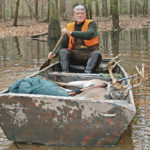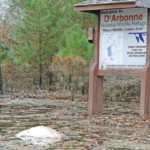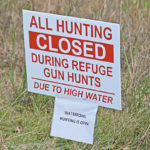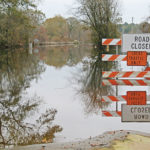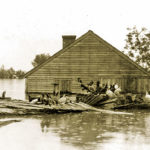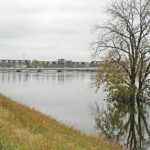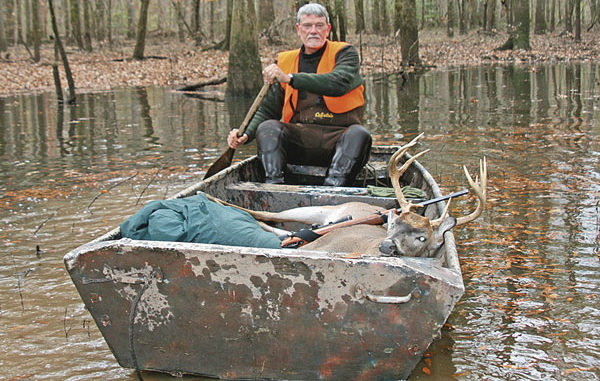
This autumn’s historic flood closed roads, fisheries and hunting seasons, but how does it compare to past flood events?
October 2009 was one of the wettest months on record for parts of Louisiana. Some areas received more than 20 inches of rain that inundated fields, woods and roads.
In some cases, the high water helped hunters who used pirogues or waders to go after deer that retreated to dry ridges. This is one of my favorite ways to hunt in Winn Parish’s Dugdemona Swamp, and I was rewarded with a nice 10-point that I called up with a Primos estrus bleat can.
But in other parts of the state, the deluge put a serious damper on hunters’ plans. As the water rose steadily higher in November, authorities closed the Poole Road on Loggy Bayou Wildlife Management Area in southeastern Bossier Parish when it was flooded.
Shortly afterward, the road was reopened but then was closed again indefinitely when an inspection revealed the flood had damaged the bridge more than originally believed.
Poole Road is the main entrance to Loggy Bayou. With its closure, hunters were forced to use boats to access the WMA for the November gun deer season.
Other WMAs suffered similar adverse effects from all the rain.
Officials were also forced to close the Cascas Road (or Grand Lake Road) on Grassy Lake WMA in Avoyelles Parish when backwater from the Red River covered it. Hunters, however, could still get around the WMA by using ATV trails or other roads that remained open.
While the flood inconvenienced hunters on Loggy Bayou and Grassy Lake, it forced the complete closure of other WMAs. Boeuf, in Caldwell Parish, was closed entirely for about a week in November.
Lowrey Moak, a biology supervisor for the Department of Wildlife and Fisheries, said, “At one time we had about 90 percent of Boeuf underwater and perhaps more than that south of Highway 4.”
Fortunately, the water receded enough for the traditional two-day either-sex deer season that begins the day after Thanksgiving. Despite the flood, the hunt was a success.
“The number of hunters was down significantly, but the harvest ratio was about normal,” Moak said. “We consider it to have been just a good overall hunt. The number of deer killed was normal for the number of hunters who showed up.
“Our self-clearing surveys show there were 868 hunters over the two days, and they killed 141 deer. Seventy-six were bucks, and 65 were does.”
Moak doesn’t think the flood will have any long-term impact.
“The deer living in that swamp are used to this sort of thing,” he said. “Floods are just a way of life for them. They know where to go to escape.”
One beneficial effect of all the water was that it attracted large numbers of ducks.
“Waterfowl hunting has been really good during the first split,” Moak said. “When that timber flooded on Boeuf, the ducks found the mast real quick. We had an excellent waterfowl season the first split.”
Most of the D’Arbonne and Upper Ouachita National Wildlife Refuges were also flooded, and federal officials were forced to close the November gun deer season, but continued to allow duck hunting.
D’Arbonne Manager Joseph McGowan believed this might have been the first time the refuge was ever closed to hunting.
“I think back in 1991 the water got about 8 inches deeper than this year, but it wasn’t during hunting season,” he said. “I don’t think we’ve ever had to close the refuge before for hunting. This year’s flood just happened at an odd time because the high water usually comes in the spring.
“We estimated Upper Ouachita had only about 500 acres out of more than 42,000 acres that were not flooded, and on D’Arbonne it was only about 1,200 out of more than 17,000 acres that remained dry.”
While driving down White’s Ferry Road to inspect the high water, I had noticed a number of deer carcasses littering the road side. Thinking perhaps they were victims of poachers, I asked McGowan about poaching problems during the flood.
“I don’t really think we had much poaching problems simply because we didn’t have any dry land where they could poach deer,” he said. “But there were a lot of deer getting hit by cars on the highway as they made their way out of the refuge, and some people who hunt on the surrounding private land just dump carcasses at the first isolated place they find.”
McGowan agreed with Moak that the flood would have a minimal effect on the animals.
“I don’t think we had much loss of wildlife from drowning,” he said. “The water came up fast, but most of them were able to get to high ground. The Ouachita River has been flooding like this long before we were here, and animals know how to adapt.”
Unlike Boeuf, the high water didn’t improve duck hunting on D’Arbonne, according to McGowan.
“Duck hunting in the first split has been spotty, if not poor,” he said. “Part of the problem is there’s so much water that it is too deep for puddle ducks. Instead of the usual 18 inches we normally have on much of the refuge, this year it’s 20 feet deep. Also, there hasn’t been any real cold weather up north to push them down. I’ve heard from people up there who say the ducks are just staying put and wearing out the grain fields.”
But there was one silver lining in D’Arbonne’s high water. Bass fishermen, such as Mike Nugent, found the fish to be biting well.
Nugent, an employee of the Department of Transportation and Development, worked on White’s Ferry Road north of West Monroe when high water forced officials to close the highway where it bordered the D’Arbonne refuge. While barricades were being put up, he noticed a man walking along the road casting for bass.
“He said he had been out there earlier and caught 13 bass,” Nugent said. “He showed me a picture on his cell phone of one that weighed a little over 9 pounds.”
Nugent came back later to try his luck, and caught seven bass that averaged about a pound and a half each. Other fishermen also discovered the bite was on, and caught limits of bass by wading down the flooded gravel road beds off White’s Ferry Road.
While sportsmen were shocked and dismayed at the extent of the water’s damage, the 2009 flood was just the latest in a number of floods that have devastated the state.
The flood of 1912 was one of the first in which officials became concerned about wildlife.
During that flood, a Gettysburg, Pa., newspaper claimed a Louisiana wildlife official had declared, “Deer and other game — but particularly deer — should be protected in the parishes which were overflowed by the flood from the Mississippi River.”
The paper went on to report, “Thousands of deer, it is estimated, were drowned or starved in the spring floods, and hundreds of others have been ruthlessly killed by the butchering huntsmen. The animals, in many instances, were driven out of their native haunts.
“During the flood period they seemed in the face of starvation to have lost all of the ancient fear of man, and many came to lie in the pastures with cattle. Others were driven to levees and mounds of high ground, some came into people’s yards and in a few instances even ran crazy with fear through business sections of towns. Before they could make their way back into the swamps, the majority of them were killed.”
In an attempt to minimize losses, the state legislature passed a bill to allow parish police juries to prohibit the killing of game animals for a limited time. Tensas Parish, however, was the only one to do so.
Even when police juries failed to take action to protect the deer, some private citizens acted on their own. After reporting that thousands of deer had drowned, an Arkansas newspaper noted that a citizen there was heading a movement to close the deer season for five years.
An Abilene, Texas, newspaper also wrote, “Many herds of deer have taken to the water, since they have been forced from their haunts by the floods, near Rayville, La., and the hardware dealers, to prevent their annihilation, are refusing to sell buckshot to the hunters.”
Sixty-one years later in the spring of 1973, another mighty flood devastated the state. That year the Mississippi River crested at 50.3 feet at Vicksburg, the highest in 36 years.
An Oil City, Pa., newspaper claimed, “If the ocean had treetops sticking out of it, it would look like Catahoula Parish, La.”
For the first time since its completion in 1950, the Morganza Spillway was opened in April to drain off some of the high water from the Mississippi River.
Once again, huge numbers of animals were displaced, but this time officials took direct steps to help them. Louisiana wildlife agents shot deer with tranquilizer darts in the flooded areas and hauled them to higher ground.
State wildlife officials also closed the spring turkey season in those areas affected by the Morganza Spillway flooding. Wildlife and Fisheries director Burton Angelle explained the measure was necessary because the high water forced the turkeys to seek shelter in small areas where they had little chance to evade hunters.
The 1973 flood displaced so many deer that they soon threatened the state’s soybean crop. Angelle reported that “thousands” of deer had been driven out of the woodlands, and were causing significant crop damage along the Mississippi River in Northeast Louisiana and in the Atchafalaya Basin.
In several states, authorities took extraordinary measures to save stranded deer that faced starvation. In Louisiana, officials began supplemental feeding programs in the Atchafalaya Basin and along the Mississippi River.
Richard Yancey, assistant director of the Wildlife and Fisheries Commission, reported, “We feel that the program resulted in saving two-thirds to three-fourths of those deer that would have otherwise died from a lack of feed.”
Yancey estimated that across the state thousands of deer were fed corn, oats, soybeans, and range pellets.
In Arkansas, several hundred deer became stranded on Montgomery Island in the Mississippi River. It was estimated that the island had two deer per acre, the highest concentration of any river island.
When it was discovered that the starving deer had eaten every bit of forage available, steps were taken to save them. Instead of feeding them corn or range pellets, however, biologists decided a more natural solution was to cut down trees and saplings to provide more browse.
Mississippi seems to have had the greatest problem with displaced wildlife during the 1973 flood.
One Greenville newspaper columnist wrote, “Deer, turkeys and other animals have been reported alongside Miss. Highway 1, both north and south of Greenville. If you are traveling on this road, watch out for the animals. … In spite of the high stage of the Mississippi River, many deer are still on the river side of the levee. Some have found high ground and are sticking it out. I have heard that in some cases, these deer are being fed my members of some hunting clubs.”
So many animals sought refuge along the Mississippi River levee that a special task force of agents was formed to protect them against poachers, dogs and well-meaning citizens.
C.B. McSwain, another official with the Mississippi Fish & Game Commission, stated, “We wanted to have a display of force for the poachers who might be headlighting or killing deer who are too weak after swimming a long distance to the levee.”
McSwain also warned the public that agents were shooting dogs found on the levee without collars so they would not kill the defenseless deer.
“Dogs are molesting deer horribly,” he declared, although he was unable to give an estimate as to how many deer the canines had killed.
Another major problem Mississippi authorities had in 1973 was well-meaning citizens trying to revive exhausted deer found along the levee in Bolivar, Washington and Issaquena counties.
“These deer swim for two miles, let’s say, and they get on the bank completely exhausted and unable to walk,” McSwain reported. “These people crowd around them and try to revive the deer. The deer are so shy and wary, they go into shock and could have a heart attack. Many times the deer jumps back into the water and drowns before the horrified eyes of the people who tried to save it.”
Just as in 2009, officials in 1973 did not expect the flood to have much of an impact on wildlife numbers.
“What is lost may not be more than what is taken out during a regular season,” McSwain reported. “It will be a limiting factor, but certainly not to the extent that it is a detrimental limiting factor.”
Authorities in both Louisiana and Mississippi also agreed that few deer actually starved during the flood. One Mississippi official theorized, “The deer that did die from starvation were probably already in bad shape or stress, and harassment played a part in it.”
This same official estimated that only about 500 out of approximately 5,000 deer that became stranded on the Mississippi River levee between Mayersville and Vicksburg died. He also stated that about 100 deer died of starvation in Louisiana in the Diamond Point area south of Vicksburg.
“We got a report that a check of jaw bones showed 90 percent of them were last year’s fawns, but other deer in the same area were found to be in good shape,” he said.
As bad as the 1912, 1973, and 2009 floods were, they still don’t compare to the historic flood of 1927.
In 1927, the Ouachita River crested at approximately 49 feet in Monroe. That was only about a foot higher than 2009, but the effects were much different, according to John Stringer of the Tensas Basin Levee District.
“Our present-day levees didn’t exist back during the 1927 flood,” he said. “There were some small levees on the Ouachita River and elsewhere, but in Monroe and West Monroe, they had to use sandbags. The present-day levee system was put in place after the 1932 flood.”
With no comprehensive levee system in place, the high water was free to go where it pleased. In May 1927, an Ohio newspaper reported that some 4,000 square miles of Northeast Louisiana had been flooded by the “racing Mississippi.”
Approximately 25 percent of the state eventually went under water, and in the Mississippi Valley, 250,000 refugees were forced to take shelter, sometimes on Indian mounds.
The Ohio newspaper also reported on a northern man named Lester who witnessed the devastation: “Mr. Lester said that deer and other animals, forced to flee from their lairs to the highlands, were being cared for and fed hay. Warnings were posted against the killing of deer. Bodies of many animals, drowned before they could reach high land, could be seen floating in the river.”
The New York Times carried many stories on the flood and claimed, “[T]he wild animals and birds of that part of Louisiana west of the Mississippi, which includes the greatest game preserve in the country, for the most part have to shift for themselves… .”
Noting that the flood had forced prey and predator to live together, the Times declared, “Mutually hostile species have been observed floating downstream together on the same logs and rafts.”
Echoing his latter-day counterparts, Stanley Arthur, director of the Louisiana Conservation Commission’s Division of Wildlife, was optimistic most of the animals would survive the flood.
“I am sure that we will find most of the Louisiana deer alive when the floods have passed,” he said. “Large numbers of them are safe on the red hills of Mississippi, and the very fact that so many of them are in that state now gives us ample reason to hope that most of the other deer are still alive on high land in the flood zones.
“I also believe that we will find most of the bears alive. But they are not in Mississippi. Some of the cubs probably were drowned, but I think that the older ones had more than an even chance.”
Arthur believed the older cubs were smart enough to save themselves and noted that sows take good care of their young.
“I am hopeful that a lot of little fellows will be saved, too,” he said.
He predicted that when the flood receded, the bears would make their way back to their natural haunts in the Tensas and Atchafalaya basins.
“As for the cougars, wolves, wildcats and other predatory animals,” Arthur declared, “few tears would be shed over their loss. There appears to be a good chance, however, that a very considerable proportion of them have successfully evaded the deluge and that in the course of time they will be as numerous as ever in the jungle fastness of the game section of Louisiana.”
Of more concern to Arthur was the survival of the marsh country’s muskrats, which were critical to the fur industry. There was a real fear the flood would ruin America’s fur industry.
In 1927, Louisiana produced twice as much fur as Canada and 15 times more than Alaska. In fact, more than half of the fur used in the nation’s garment industry came from the Bayou State.
To get a firsthand look at the devastation, Arthur and a colleague took an extended canoe trip through St. Bernard and Plaquemines parishes, which he reported were “little more than a great lake.”
Upon his return, Authur gave a fascinating report on the effect the 1927 flood had on the marsh wildlife.
“In our four-day inspection of the muskrat area, I saw thousands of muskrats in the flood waters,” he said. “Everything that floated — a log, a piece of plank, anything that was buoyant — was carrying its load of refugee rats.
“On the roofs of buildings, on the limbs of trees that still were above water were other refugees, and sometimes they were sharing their haven with raccoons and rabbits, and now and then, even snakes.”
Arthur also reported that the muskrats had lost their natural fear of man.
“As [we] paddled our canoe through the flood waters … some of the rats … weakened by the long struggle for life in the water, headed straight for our boat,” he said. “They would climb up on the paddles, cling to the side of the canoe, and wait for us to take them in our hands and drop them in the bottom of the canoe.”
The muskrats immediately relieved themselves and then fell asleep.
Arthur noticed that some of the area trappers had implemented a rather ingenious conservation tactic by setting rafts adrift for the muskrats to climb onto. When he and his companion came across one of the rafts, they transferred their muskrat cargo to it so they could pick up some more.
“All this may sound a bit fantastic,” Arthur admitted, “but it so happens it is the truth.”
Thanks to the trappers’ rafts, Arthur estimated that 50 percent of the muskrats in St. Bernard and Plaquemines parishes would survive the flood.
Arthur was impressed with the survival instinct of all the marsh’s inhabitants.
“I have seen snakes, raccoons, mink and rats all on the same log each holding on for dear life and past enmities entirely forgotten. … On top of one floating hen house, the sight that met our eyes was two big rabbits and a half dozen full-grown rats. They were brothers in distress, and it seemed they knew it.
“On some of the muskrat rafts not only rabbits but also mink and sometimes snakes found a refuge. Here I am afraid the fraternity spirit did not last, for minks are noted for their love of muskrat chops and the snake is quite fond of rabbit meat.
“It is a pitiable sight to watch the antics of some of the rats trying to save themselves. We frequently find the mice, as the baby muskrats are called, clinging to the tips of cattails protruding from the water. Often four or five mice will be clinging to a bunch of cattails, while the mother muskrat frantically swims around the water, occasionally diving down and bringing up shreds of grass for her young. Sometimes the mother will turn over on her back next to the cattails, so that her young can feed from her breast. And so the battle goes on.”
In his summary of the 1927 flood’s effect on Louisiana’s wildlife, Arthur ended on an optimistic note that today’s sportsmen should keep in mind when the next great deluge occurs.
“It’s a great problem this wildlife of Louisiana, and we have got to solve it. … This will probably prove to be the darkest year in our history, but we will emerge from the gloom of it and in due course.”
